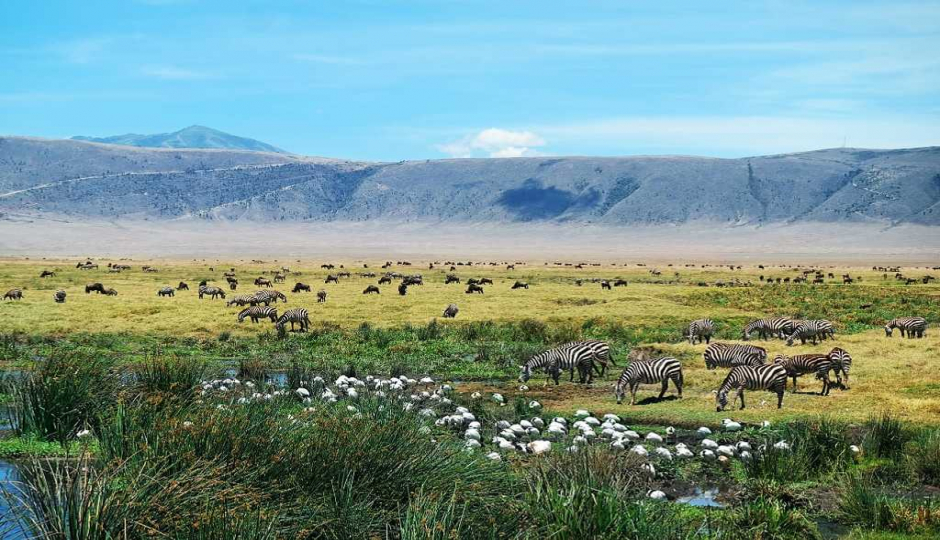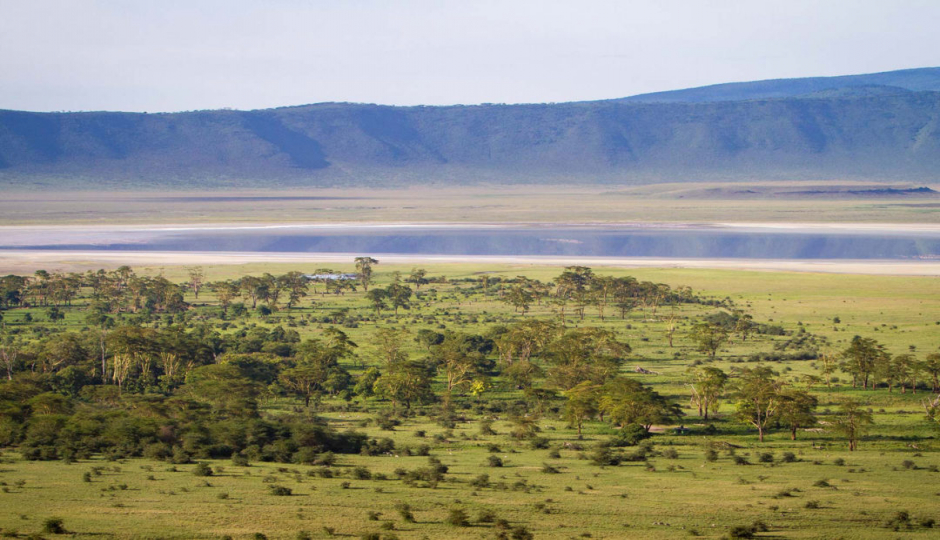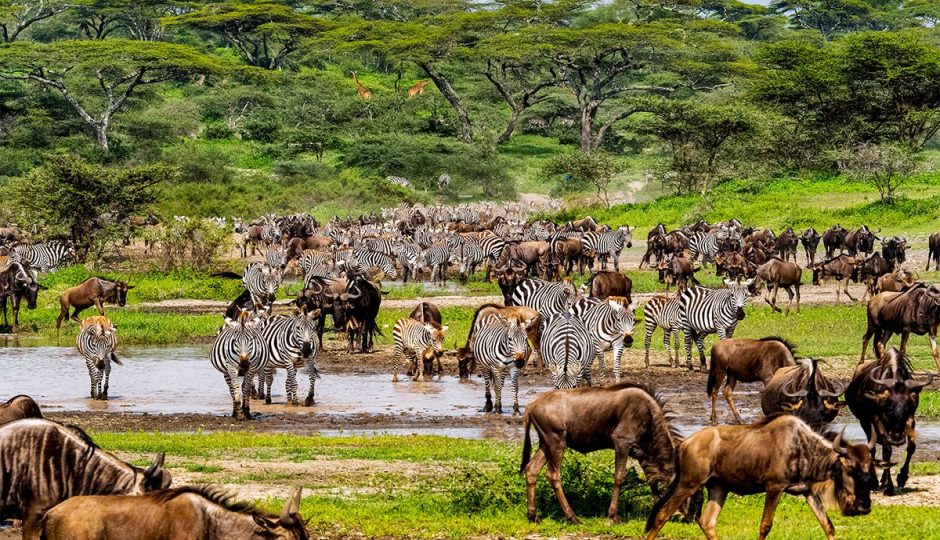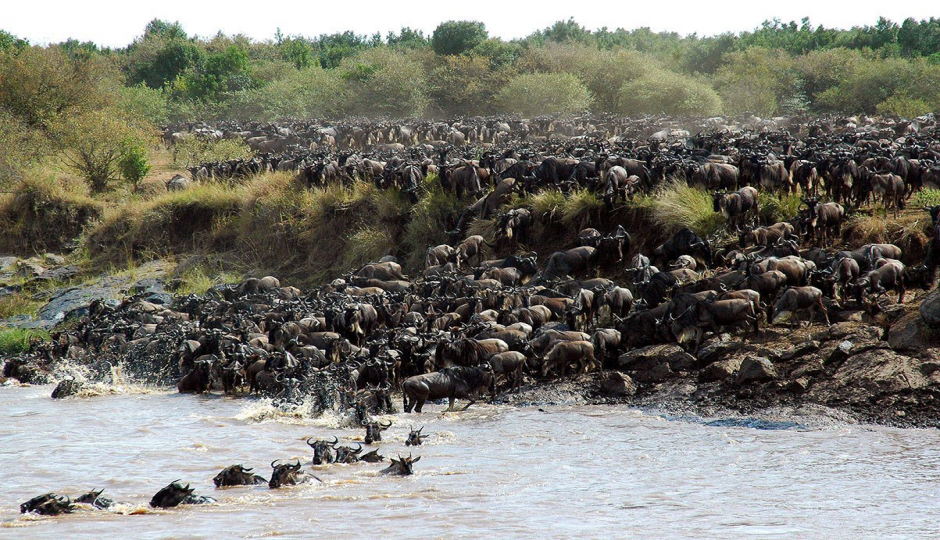







Embark on a virtual safari through the untamed landscapes of northern Tanzania as we unveil the wonders of wildlife game viewing in seven extraordinary destinations. From the iconic plains of Serengeti to the hidden gems like Mkomazi, each location promises a unique and immersive encounter with Africa's magnificent fauna.
Join us as we explore the diverse ecosystems of Tarangire, the flamingo-fringed shores of Lake Manyara, and the awe-inspiring slopes of Kilimanjaro National Park. Discover the secrets of Arusha National Park, where nature's tapestry comes alive.
Whether you're a seasoned safari enthusiast or a first-time explorer, this guide will take you on a journey through the heart of northern Tanzania, offering insights into the rich biodiversity, cultural interactions, and the unparalleled thrill of witnessing wildlife in their natural habitats. Get ready to add these seven destinations to your bucket list and experience the raw beauty of Africa's wilderness. Are you ready for the adventure of a lifetime? Let's begin the exploration
1: Serengeti National Park: Where Wildlife Roams Free
Serengeti National Park, located in northern Tanzania, is a natural masterpiece that epitomizes the untamed beauty of the African savannah. Spanning over 14,750 square kilometers, it is renowned for its sweeping landscapes, diverse ecosystems, and, most notably, the annual Great Migration.
Key Features
Great Migration: Witness one of nature's greatest spectacles as millions of wildebeest, zebras, and other herbivores embark on a perilous journey in search of fresh grazing lands. The migration is a breathtaking display of survival instincts and predator-prey interactions.
Abundant Wildlife: Home to the "Big Five" – lions, elephants, buffalos, leopards, and rhinoceros – Serengeti boasts an unparalleled concentration of diverse wildlife. The park's vast plains provide an ideal habitat for numerous species, making every safari a thrilling adventure.
Balloon Safaris: Soar above the Serengeti in a hot air balloon for a mesmerizing aerial view of the landscape and its inhabitants. This unique perspective offers a sense of tranquility and allows for unparalleled photo opportunities.
Cultural Heritage: Beyond its natural wonders, Serengeti National Park is rich in cultural significance. Explore the traditions of the Maasai people, who coexist with the wildlife, and gain insights into their sustainable way of life.
Why Visit Serengeti
Unparalleled Wildlife Viewing: Serengeti provides an unmatched opportunity to witness diverse wildlife in their natural habitat. The sheer abundance of animals ensures that every safari holds the promise of extraordinary encounters.
Epic Landscapes: The sweeping plains, acacia-dotted savannahs, and rocky outcrops create a breathtaking backdrop for wildlife photography and an immersive safari experience.
Conservation Success: Serengeti has been at the forefront of successful conservation efforts, preserving the delicate balance of ecosystems and ensuring the survival of endangered species. Visitors contribute to the ongoing protection of this natural treasure.
Unique Experiences: From thrilling game drives to serene balloon safaris, Serengeti offers a range of experiences that cater to both adventure seekers and those seeking a more tranquil connection with nature.
In essence, Serengeti National Park beckons with its unrivaled beauty, offering an opportunity to connect with the wild in a way that leaves a lasting imprint on the soul. A visit to Serengeti is a journey into the heart of Africa's wilderness, where the rhythms of nature unfold in a spectacular and unscripted symphony.
2: Mkomazi National Park: A Hidden Gem of Eastern Tanzania
Nestled in the heart of eastern Tanzania, Mkomazi National Park is a pristine wilderness that remains largely undiscovered, offering a unique and off-the-beaten-path safari experience. Covering an expansive 3,234 square kilometers, the park is characterized by its diverse landscapes, rich biodiversity, and a commitment to conservation.
Key Features
Scenic Landscapes: Mkomazi is a tapestry of contrasting ecosystems, featuring rolling savannahs, acacia woodlands, and rugged hills. The park's diverse terrain provides a picturesque setting for exploration and wildlife observation.
Abundant Wildlife: Though smaller in size compared to some of its renowned counterparts, Mkomazi is home to a remarkable array of wildlife. Encounter species such as elephants, giraffes, zebras, and various antelope species. The park is also a haven for bird enthusiasts, boasting over 450 bird species.
Black Rhino Sanctuary: Mkomazi plays a crucial role in the conservation of the endangered black rhinoceros. The park serves as a sanctuary for these majestic creatures, offering a rare opportunity to witness them in their natural habitat and contribute to their preservation.
Cultural Heritage: Mkomazi is not only a wildlife sanctuary but also a place where the local communities, particularly the Wazaramo and Maasai, coexist with nature. Engage in cultural experiences to gain insights into traditional practices, crafts, and sustainable living.
Why Visit Mkomazi
Secluded Safari Experience: Mkomazi National Park offers a tranquil and less crowded safari experience compared to more popular destinations. This allows for a more intimate connection with nature and wildlife, enhancing the sense of adventure.
Conservation Success: By visiting Mkomazi, you actively support conservation efforts aimed at protecting endangered species, particularly the black rhino. Your contribution goes toward sustaining the delicate balance of the ecosystem and ensuring the survival of vulnerable wildlife.
Authentic Cultural Encounters: Interact with local communities and experience the unique traditions of the Wazaramo and Maasai people. This cultural exchange adds depth to your safari, providing a holistic understanding of the interconnectedness between people and nature.
Photographic Opportunities: The varied landscapes of Mkomazi, coupled with its diverse wildlife, present excellent opportunities for photographers. Capture stunning moments against the backdrop of the park's scenic beauty and unique flora and fauna.
Mkomazi National Park beckons to those seeking an authentic and immersive safari experience off the beaten path. It is a destination where conservation, cultural heritage, and the allure of the wild converge to create a truly enriching adventure.
03: Tarangire National Park: A Tapestry of Wildlife and Baobab Giants
Nestled in northern Tanzania, Tarangire National Park stands as a testament to the untamed beauty of East Africa. Spanning over 2,850 square kilometers, the park is distinguished by its iconic baobab trees, expansive savannahs, and the meandering Tarangire River, making it a must-visit destination for nature enthusiasts and safari aficionados.
Key Features:
Baobab Wonderland: Tarangire is renowned for its striking landscape adorned with ancient baobab trees. These majestic giants, with their unique shapes and sizes, create a surreal atmosphere that adds a touch of magic to the park's scenery.
Wildlife Extravaganza: The Park is a haven for diverse wildlife, boasting one of the highest concentrations of elephants in the world. Encounter a symphony of species, including lions, leopards, cheetahs, and an array of ungulates. The Tarangire River serves as a lifeline, drawing wildlife in search of water, and offering spectacular game viewing opportunities.
Birding Paradise: Tarangire is a paradise for bird enthusiasts, hosting over 550 bird species. The park's varied habitats, from riverbanks to swamps, attract a colorful array of feathered inhabitants, making it an ideal destination for birdwatching.
Scenic Beauty: The vast grasslands, interspersed with acacia trees and rocky outcrops, create a visually stunning backdrop for safaris. The landscape changes dramatically with the seasons, from lush greenery in the wet season to golden hues during the dry months.
Why Visit Tarangire
Intimate Safari Experience: Tarangire offers a more intimate and less crowded safari experience compared to some of its more famous neighbors. The expansive wilderness provides a sense of solitude, allowing visitors to connect with nature on a profound level.
Elephant Migration: Witness the awe-inspiring sight of large herds of elephants during their seasonal migration. Tarangire becomes a sanctuary for these gentle giants, providing a unique opportunity to observe their natural behaviors in a pristine environment.
Cultural Encounters: Engage with the local Maasai communities surrounding the park, gaining insights into their traditional way of life. Cultural interactions add depth to your safari, creating a holistic understanding of the region's rich heritage.
Photographic Delight: The unique landscapes, vibrant wildlife, and magnificent baobabs make Tarangire a paradise for photographers. Capture unforgettable moments against the backdrop of the park's scenic beauty.
Tarangire National Park beckons with its unique blend of wildlife spectacle, natural beauty, and cultural richness. It is a destination that promises an authentic safari experience, where every moment unfolds as a testament to the raw and untouched allure of the African wilderness.
4: Ngorongoro Conservation Area: A Cradle of Wildlife Wonders
Ngorongoro Conservation Area, situated in northern Tanzania, is a geological marvel and a haven for biodiversity. Spanning over 8,292 square kilometers, this UNESCO World Heritage Site is home to the iconic Ngorongoro Crater and an array of ecosystems, making it a captivating destination for those seeking a unique blend of natural beauty and wildlife spectacle.
Key Features
Ngorongoro Crater: The centerpiece of the conservation area, the Ngorongoro Crater, is a colossal volcanic caldera that shelters an astonishing concentration of wildlife. Its floor, a lush and fertile expanse, provides a self-contained ecosystem where diverse species coexist in harmony.
Rich Wildlife Diversity: Ngorongoro boasts an unparalleled array of wildlife, including the "Big Five" – lions, elephants, buffalos, leopards, and rhinoceros. The crater's unique environment supports a high density of predators and herbivores, creating a remarkable tableau of nature's interconnected web.
Maasai Culture: Beyond its natural wonders, Ngorongoro is also home to Maasai pastoralists who have lived in harmony with the wildlife for centuries. Cultural visits allow you to engage with Maasai communities, gaining insights into their traditions, rituals, and sustainable coexistence with the environment.
Olduvai Gorge: Known as the "Cradle of Mankind," the Olduvai Gorge within the conservation area is an archaeological treasure trove. It has provided valuable insights into human evolution, with fossil discoveries dating back millions of years.
Why Visit Ngorongoro
Unique Crater Safari: Experience a safari like no other within the Ngorongoro Crater, where the enclosed environment offers an extraordinary concentration of wildlife. The breathtaking landscapes and diverse habitats provide a setting for unparalleled game viewing.
Cultural Immersion: Interact with the Maasai people and witness their traditional way of life. Cultural experiences add depth to your visit, fostering an appreciation for the harmonious relationship between the indigenous communities and the natural world.
Paleontological Significance: Explore the Olduvai Gorge to discover the birthplace of some of the earliest human ancestors. The gorge's significance in paleontology adds an educational dimension to your journey, offering a glimpse into our shared evolutionary history.
Stunning Scenery: Ngorongoro's varied landscapes, from the crater floor to the highlands, present breathtaking vistas at every turn. The dramatic scenery, coupled with the abundant wildlife, creates a captivating backdrop for photographers and nature enthusiasts.
Ngorongoro Conservation Area beckons adventurers and nature lovers with its extraordinary blend of wildlife, culture, and geological wonders. It is a destination where the ancient and the contemporary coalesce, offering a journey into the heart of Africa's natural and cultural heritage.
5: Arusha National Park: A Tapestry of Nature's Diversity
Nestled at the foothills of Mount Meru in northern Tanzania, Arusha National Park is a hidden gem that encapsulates the essence of East Africa's natural beauty. Spanning over 552 square kilometers, the park's varied landscapes, diverse wildlife, and proximity to Arusha, the safari gateway, make it a captivating destination for those seeking a blend of adventure and tranquility.
Key Features
Mount Meru: The Park is dominated by the majestic Mount Meru, the fifth-highest peak in Africa. The dormant volcano offers challenging trekking opportunities, rewarding climbers with panoramic views of the surrounding landscapes and, on clear days, distant views of Mount Kilimanjaro.
Momela Lakes: Arusha National Park is adorned with a series of shimmering alkaline lakes known as the Momela Lakes. Each lake is unique, ranging from the emerald-green waters of Lake Manyara to the pink hues of Lake Magadi. The lakes attract a variety of birdlife and wildlife.
Ngurdoto Crater: Resembling a smaller version of the Ngorongoro Crater, Ngurdoto Crater is a haven for wildlife. The lush vegetation and forested rim create a picturesque setting, and the crater floor is home to a variety of animals, including buffalos, warthogs, and a profusion of bird species.
Colobus Monkey Forest: The Park is renowned for its Colobus Monkey population. The tranquil forested areas provide a habitat for these striking black-and-white primates, offering visitors a chance to observe their playful antics in their natural environment.
Why Visit Arusha National Park
Diverse Landscapes in a Compact Area: Arusha National Park offers a remarkable variety of landscapes within a relatively small area. From the grassy savannahs and wooded hills to the alpine meadows and volcanic craters, the park provides a microcosm of East Africa's ecosystems.
Accessibility: Proximity to Arusha, a major hub for safaris, makes Arusha National Park easily accessible for day trips or as the starting point for longer adventures. It's an ideal introduction to the wonders of Tanzanian wildlife and landscapes.
Mount Meru Climbing: For adventure seekers, Mount Meru provides a less crowded but equally stunning alternative to Mount Kilimanjaro. The climb is challenging, rewarding trekkers with breathtaking views and a sense of accomplishment.
Birdwatching Paradise: With over 400 bird species recorded, Arusha National Park is a haven for birdwatchers. The diverse habitats, including lakes, forests, and open savannahs, attract a wide array of avian species.
Arusha National Park beckons with its compact yet diverse landscapes, making it an ideal starting point for a Tanzanian safari adventure. Whether trekking up Mount Meru, embarking on a wildlife safari, or simply immersing yourself in the tranquility of nature, the park promises a rich tapestry of experiences for all who venture within its borders.
6: Lake Manyara National Park: Where Wildlife Meets Water's Edge
Nestled between the dramatic Rift Valley Escarpment and the glistening waters of Lake Manyara, this Tanzanian gem, Lake Manyara National Park, offers a unique blend of diverse ecosystems and an abundance of wildlife. Covering approximately 330 square kilometers, the park's compact size belies its richness in biodiversity and scenic beauty.
Key Features
Flamingo-Fringed Lake: Lake Manyara, a shallow alkaline lake, stretches along the park's western boundary, often adorned with vibrant pink hues as thousands of flamingos gather along its shores. The lake's reflective surface adds a serene backdrop to the diverse landscapes of the park.
Tree-Climbing Lions: Lake Manyara is renowned for its unique population of tree-climbing lions. Witness these majestic big cats lounging on the branches of acacia trees, showcasing a behavior rarely observed in other African parks.
Rich Birdlife: The Park is a haven for bird enthusiasts, with over 400 bird species recorded. From the iconic flamingos in the lake to the varied waterfowl, raptors, and colorful songbirds, Lake Manyara offers a birdwatcher's paradise.
Lush Groundwater Forest: The groundwater forest, fed by underground springs, provides a cool and verdant haven. Here, visitors can encounter troops of baboons, blue monkeys, and elusive bushbucks amidst the dense foliage.
Why Visit Lake Manyara National Park
Scenic Diversity: Lake Manyara National Park seamlessly transitions from the lake's shores to dense woodlands and open grassy plains. The dramatic backdrop of the Rift Valley Escarpment adds a picturesque element to the park's scenery, making it a captivating destination for nature lovers and photographers.
Tree-Climbing Lions: Lake Manyara is one of the few places in Africa where lions exhibit tree-climbing behavior. This unique spectacle provides a rare and memorable safari experience, allowing visitors to witness the big cats in a distinctive setting.
Birdwatcher's Paradise: With its diverse habitats, from the lake and wetlands to the groundwater forest, Lake Manyara attracts a wide array of bird species. Birdwatchers can spot everything from waterfowl to raptors and smaller colorful birds.
Proximity to Ngorongoro and Serengeti: Lake Manyara is conveniently located near other iconic Tanzanian safari destinations such as Ngorongoro Crater and Serengeti National Park, making it an excellent addition to a broader safari itinerary.
Lake Manyara National Park enchants visitors with its distinctive landscapes, rare wildlife sightings, and a serene ambiance. Whether it's the reflective waters of the lake, the captivating tree-climbing lions, or the diverse birdlife, the park promises a safari experience that is both unique and unforgettable.
07: Kilimanjaro National Park: Summiting Africa's Roof, Embracing Nature's Grandeur
Nestled in northern Tanzania, Kilimanjaro National Park encompasses the awe-inspiring Mount Kilimanjaro, Africa's highest peak and one of the world's most iconic landmarks. The park, covering around 1,668 square kilometers, is a UNESCO World Heritage Site that draws adventurers and nature enthusiasts alike, offering not only a challenging climb but also a diverse range of ecosystems on its slopes.
Key Features
Majestic Mount Kilimanjaro: Dominating the park's skyline, Mount Kilimanjaro stands at 5,895 meters (19,341 feet). Its snow-capped summit, known as Uhuru Peak, beckons climbers from around the globe, providing a challenging yet rewarding trek through lush rainforests, alpine meadows, and barren volcanic landscapes.
Unique Ecological Zones: Kilimanjaro's slopes harbor five distinct ecological zones, each characterized by its flora and fauna. From the lush rainforest at the mountain base to the alpine desert near the summit, climbers traverse diverse landscapes that showcase the effects of altitude and climate.
Shira Plateau: The Shira Plateau, an expansive high-altitude plateau, offers breathtaking vistas of the surrounding landscapes. It serves as a transitional zone between the rainforest and the higher, more barren reaches of the mountain.
Kibo Crater: The dormant volcanic cone of Kibo, one of Kilimanjaro's three peaks, shelters the famous Uhuru Peak. Climbers reach the rim of the Kibo Crater before making the final ascent to the summit, enjoying panoramic views of the crater's interior and the surrounding plains.
Why Climb Kilimanjaro
Africa's Highest Peak: Standing atop Mount Kilimanjaro's summit is a profound achievement, providing climbers with unparalleled views of the African continent below. The sense of accomplishment in reaching Uhuru Peak is a testament to determination and resilience.
Ecological Diversity: The climb up Kilimanjaro is a journey through diverse ecological zones, ranging from the lush rainforest to the alpine desert. Climbers witness a unique cross-section of ecosystems, each with its own distinctive plant and animal life.
Cultural Experience: Kilimanjaro is intertwined with local Chagga culture. Many routes pass through Chagga villages, offering climbers the opportunity to engage with local communities, witness their traditional practices, and gain insights into their way of life.
Adventure and Personal Challenge: Climbing Kilimanjaro is an adventure that challenges both the physical and mental fortitude of climbers. The trek provides an opportunity for self-discovery, resilience, and the satisfaction of overcoming personal limits.
Kilimanjaro National Park encapsulates the spirit of adventure and the wonders of nature. Whether you're scaling its peaks or marveling at its diverse ecosystems, Kilimanjaro promises an unforgettable experience that combines the thrill of adventure with the tranquility of nature's grandeur.






What is a Reasonable Tanzania Safari Itinerary?
How Do I Plan a Kilimanjaro Climb?
To book your adventure, simply send us an email detailing your desired experience—whether it's climbing Mount Kilimanjaro, going on a Tanzania safari, or enjoying the Zanzibar beach.
We'll promptly respond with all the information you need to finalize your plans. Plus, we offer the convenience of online payment to make the process even smoother.
View Packages